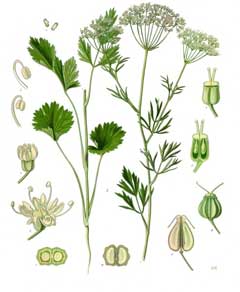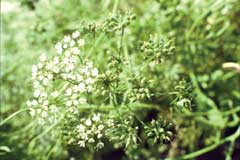 |
|
http://commons.wikimedia.org/wiki/File:Koeh-240.jpg |
 |
|
Translate this page:
Summary
Physical Characteristics

 Pimpinella anisum is a ANNUAL growing to 0.5 m (1ft 8in) by 0.2 m (0ft 8in).
Pimpinella anisum is a ANNUAL growing to 0.5 m (1ft 8in) by 0.2 m (0ft 8in).
See above for USDA hardiness. It is hardy to UK zone 8 and is frost tender. It is in leaf from May to October, in flower in July, and the seeds ripen from August to September. The species is hermaphrodite (has both male and female organs) and is pollinated by Insects. The plant is self-fertile.
Suitable for: light (sandy) and medium (loamy) soils and prefers well-drained soil. Suitable pH: mildly acid, neutral and basic (mildly alkaline) soils. It cannot grow in the shade. It prefers dry or moist soil.
UK Hardiness Map
US Hardiness Map
Synonyms
Anisum odoratum, Anisum officinale, Anisum officinarum, Anisum vulgare
Plant Habitats
Cultivated Beds;
Edible Uses
Edible Parts: Leaves Seed
Edible Uses: Condiment Tea
Young leaves - raw or cooked[2, 14, 21, 37, 52]. The leaves have a sweet aniseed flavour, they are very refreshing to chew and are also nice as a flavouring in salads, puddings, soups, stews etc[183, K]. When adding to cooked dishes, only add the leaves for the last few minutes of the cooking or the flavour will be lost[K]. The aromatic seed is eaten raw or used as a flavouring in raw or cooked foods such as soups, pies, bread and cakes[2, 14, 20, 21, 27, 37, 244]. A distinctive sweet liquorice flavour[183], its use improves the body's ability to digest food[244]. The seed is harvested by cutting the whole plant when the seed is ripe. The plants are then kept in a warm, dry position for a week and then threshed to remove the seeds. Store the seeds in the dark in an airtight jar[244]. An essential oil from the seed is used as a food flavouring in sweets (especially aniseed balls) ice cream, chewing gum, pickles etc[57, 183, 238]. It is also often used to flavour alcoholic drinks such as pernod, ouzo and anisette[238, 244]. The leaves and the seeds can be brewed into a sweet liquorice-like tea[183].
References More on Edible Uses
Medicinal Uses
Plants For A Future can not take any responsibility for any adverse effects from the use of plants. Always seek advice from a professional before using a plant medicinally.
Antiseptic Antispasmodic Appetizer Aromatic Carminative Digestive Expectorant Galactogogue
Pectoral Stimulant Stomachic Tonic
Aniseed has a delicious sweet liquorice-like flavour and is a commonly used and very safe herbal remedy that is well suited for all age groups from children to the elderly. However, its use has declined in recent years with the advent of cheaper substitutes such as Illicium verrum and synthetic substances[238]. It is a particularly useful tonic to the whole digestive system and its antispasmodic and expectorant effects make it of value in the treatment of various respiratory problems[254]. The seed is the part used, generally in the form of an extracted essential oil[4]. The essential oil comprises 70 - 90% anethole, which has an observed oestrogenic effect whilst the seed is also mildly oestrogenic[254]. This effect may substantiate the herb's use as a stimulant of sexual drive and of breast-milk production[254]. The essential oil should not be used internally unless under professional supervision whilst the seeds are best not used medicinally by pregnant women, though normal culinary quantities are quite safe[254]. The seed is antiseptic, antispasmodic, aromatic, carminative, digestive, expectorant, pectoral, stimulant, stomachic and tonic[4, 9, 14, 20, 21, 46, 165, 201]. It is of great value when taken internally in the treatment of asthma, whooping couch, coughs and pectoral affections as well as digestive disorders such as wind, bloating, colic, nausea and indigestion[4, 254]. Externally it is used to treat infestations of lice, scabies and as a chest rub in cases of bronchial disorders[238]. A strong decoction of the seeds can be applied externally to swollen breasts or to stimulate the flow of milk[244]. The German Commission E Monographs, a therapeutic guide to herbal medicine, approve Pimpinella anisum for cough and bronchitis, fevers and colds, common cold, inflammation of the mouth and pharynx, dyspepsia, loss of appetite (see [302] for critics of commission E). Contraindicated in patients allergic to anise and anethol. Sensitization as an adverse effect observed rarely.
References More on Medicinal Uses
The Bookshop: Edible Plant Books
Our Latest books on Perennial Plants For Food Forests and Permaculture Gardens in paperback or digital formats.

Edible Tropical Plants
Food Forest Plants for Hotter Conditions: 250+ Plants For Tropical Food Forests & Permaculture Gardens.
More

Edible Temperate Plants
Plants for Your Food Forest: 500 Plants for Temperate Food Forests & Permaculture Gardens.
More

More Books
PFAF have eight books available in paperback and digital formats. Browse the shop for more information.
Shop Now
Other Uses
Essential Insecticide Pot-pourri Repellent Teeth
An essential oil is obtained from the seed, used in perfumery, tooth pastes, medicinally and as a food flavouring[57, 238]. The powdered seed can be used as a dentrifice and mouthwash[201]. The plant is an ingredient of pot-pourri. The plant can be used as an insect repellent but it is also said to attract mice[14]. If aniseed oil is liberally smeared around live-traps it can attract mice and other rodents into them[4, 201]. The plants seem to be immune to the predations of slugs and snails and can help to protect neighbouring plants[201]. A spray made by boiling of one part coriander leaves and one part anise seeds in two parts of water is very effective against red spider mites and woolly aphids[201].
Special Uses
Scented Plants
References More on Other Uses
Cultivation details
Succeeds in ordinary garden soil[1] but prefers a fairly rich warm well-drained light soil in a sunny position[1, 27, 37, 52]. Prefers a pH in the range 6 to 7.5[238]. Aniseed has a very long history of herbal and culinary use, and is often cultivated for its edible and medicinal seed in warm temperate zones[46, 244]. The plant needs warm summers if it is to grow well and seeds only ripen in Britain in long warm summers[4, 37, 200]. Plants strongly resent root disturbance and should not be transplanted. A good companion plant in the garden, its aromatic nature helping to keep nearby plants free of aphis etc. Its flowers attract parasitic wasps to the garden and these prey on a large number of garden pests[238]. Aniseed grows especially well with coriander[18, 20, 201].
References Carbon Farming Information and Carbon Sequestration Information
Temperature Converter
Type a value in the Celsius field to convert the value to Fahrenheit:
Fahrenheit:
The PFAF Bookshop
Plants For A Future have a number of books available in paperback and digital form. Book titles include Edible Plants, Edible Perennials, Edible Trees,Edible Shrubs, Woodland Gardening, and Temperate Food Forest Plants. Our new book is Food Forest Plants For Hotter Conditions (Tropical and Sub-Tropical).
Shop Now
Plant Propagation
Seed - sow mid to late spring in situ. This sowing only succeeds in producing a crop of ripe seeds in years when the summers are hot[238]. A more certain crop (but much more labour intensive) can be obtained by sowing 4 - 5 seeds per pot in a greenhouse in early spring. They should germinate within 3 weeks. Thin if necessary to the best seedling and plant them out after the last expected frosts[K]. Aniseed strongly resents root disturbance.
Other Names
If available other names are mentioned here
Native Range
Coming Soon
Weed Potential
Right plant wrong place. We are currently updating this section.
Please note that a plant may be invasive in one area but may not in your area so it's worth checking.
Conservation Status
IUCN Red List of Threatened Plants Status :

Growth: S = slow M = medium F = fast. Soil: L = light (sandy) M = medium H = heavy (clay). pH: A = acid N = neutral B = basic (alkaline). Shade: F = full shade S = semi-shade N = no shade. Moisture: D = dry M = Moist We = wet Wa = water.
Now available:
Food Forest Plants for Mediterranean Conditions
350+ Perennial Plants For Mediterranean and Drier Food Forests and Permaculture Gardens.
[Paperback and eBook]
This is the third in Plants For A Future's series of plant guides for food forests tailored to
specific climate zones. Following volumes on temperate and tropical ecosystems, this book focuses
on species suited to Mediterranean conditions—regions with hot, dry summers and cool, wet winters,
often facing the added challenge of climate change.
Read More
Expert comment
Author
L.
Botanical References
50200
Links / References
For a list of references used on this page please go here
Readers comment